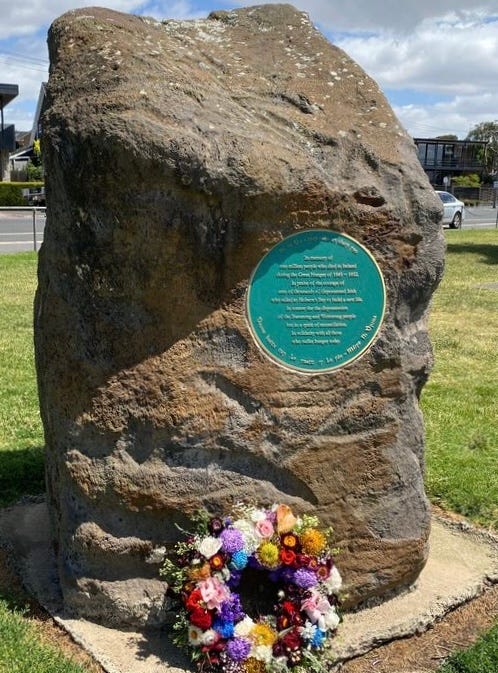Famine and the Earl Grey Girl in My Family
Irish Potato Famine sent over 4,00 young Irish girls to Australia, between 1848 and 1850. My 2x great grandmother was an Earl Grey Famine girl who came to live a long and successful life.
Our guest writer,
writes for her publication and joins us as part of our first cohort in the Projectkin Members’ Corner. Monthly posts from members celebrate their contributions to family history storytelling — in all its forms. Posts may be written or recorded (audio or video) will be shared for free each month. Explore the entire Members’ Corner here.
The Irish Potato Famine, also known as the Great Hunger, began in 1845 and lasted until 1852. Disease of the potato crop, caused mass starvation and a crisis of hunger, across Ireland. Over 1 million people died, and many left Ireland to look for food and a better life.
Many of those who stayed in Ireland, found themselves in poor houses, as the only means of support.
The Earl Grey Scheme
As things went from bad to worse, it was recognised that Ireland needed to decrease its population. Earl Grey, Secretary of State for the Colonies, devised a scheme that would become controversial, but would solve the problems of overcrowding and hunger in Ireland. This program sent over 4,000 young Irish girls to Australia, between 1848 and 1850. Many, but not all, were orphans. It was thought that the scheme would also supply females to Australia, to be female labourers and wives. At that time, females were in very short supply.
The scheme was quite controversial in Australia, as many colonists thought the girls to be low life paupers and criminals, and not the type of people needed to create the new colony. The Earl Grey scheme was terminated in 1850, after operating for only two years.
The outcome of these young girls being sent to Australia was very mixed and depended on the circumstances they found themselves in, the support they received, and of course, a large amount of luck. There were girls who from the beginning, faced abuse, exploitation, discrimination, and poverty, some dying young, and others finding themselves in Australian institutions. There were other girls who were much more fortunate and prospered, married, raised families, and left a lasting legacy to their families and to their new country.
Ellen Boyle’s Journey on The Lady Kennaway
My 2x great grandmother was an Earl Grey Famine girl who came to live a long and successful life in Australia. Ellen was born in Inver, Donegal in 1833. During the Great Hunger and after the death of her father, her mother was unable to support her and she found herself in a workhouse in Donegal.
On 11 September 1848, Ellen Boyle departed Plymouth bound for Australia on The Lady Kennaway, the first ship carrying Irish orphan girls to Australia. On board were 191 young girls, aged about 15-16 years. They arrived at Williamstown on 6 December 1848, and were taken to the immigration centre, where they were met by prospective sponsors and employers.
Ellen Boyle was immediately employed as a housemaid, by Charles Ryan of Doogalook, a large sheep grazing property in Victoria. Charles Ryan and his family were very prominent in the early settlement of Victoria.
Doogalook, William Calnan, and Violet Town
It’s possible that Ellen Boyle met her future husband while working at Doogalook, as she and William Calnan married almost one year after she arrived in Australia. William Calnan came to Australia from Kilkenny, Ireland. They married at St. Francis church in Melbourne on 12 November 1849. At the time of her marriage, Ellen was aged 16 years.
William and Ellen went on to settle on their own farming land, just outside Violet Town, where William became a successful and well respected farmer. They had a long marriage and Ellen gave birth to twelve children, six boys and six girls.
Most of the Irish famine girls had no expectation when they left Ireland, that they would ever see the families they left behind. I’m sure Ellen Boyle was very excited when in 1857, she was able to reunite with her mother and her older brother, Patrick and his daughters, when they arrived in Melbourne on the SS Pomona. The newly arrived Boyle family settled immediately in the Violet Town area, and Patrick also became a successful farmer, with the family living close to where Ellen and William Calnan were living.
Ellen’s husband, William passed away in 1883, and Ellen continued to farm the property, for a few more years, along with her sons, until she moved into the town of Violet Town. Ellen Boyle died on 14 November 1896, at her home in Catherine Street Violet Town. She was aged 63 years.
Obituary
From Violet Town Sentinel, 20 November 1896
Mrs. Calnan, a resident of the district, for about 40 years passed away on Friday last, death resulting from influenza and pneumonia. Deceased, who was 63 years of age, and a native of Donegal, Ireland, arrived in the colony early in the century, and soon afterwards settled in the district, where she resided up to the time of her death.
During her residence here, she made a large circle of friends, by her kind and sympathetic disposition, being always ready to help the needy. She was a strict adherent of the Roman Catholic Church, and her life was an example worthy of copying by those with whom she came in contact.
During the last few months, she had been ailing slightly, not to such an extent as would lead anyone to believe that death was so near. Therefore, her demise was unexpected, and came as a shock to her many friends.
Deceased was a sister of Mrs. Boyle, and leaves a large family - all of whom are grown up - to mourn her loss. Deep sympathy is expressed for the bereaved ones. Her remains were interred in the local cemetery on Sunday afternoon. The funeral cortege being one of the largest ever seen in Violet Town. The mourners at the grave were led by the very Rev. Dean Davy of Benalla and the mortuary arrangements were satisfactorily carried out by Riddell Bros.
It’s difficult to generalise whether the Earl Grey orphan scheme was successful, as the girls had different experiences, and came from different counties, workhouses and backgrounds in Ireland. They settled in different regions around Australia with various occupations and social groups which led to their experiences of life being wide and varied. Many faced huge challenges, and quite often, ignorance of the locals, as to the type of girls they were. I imagine that there were girls who would have thought they made the right decision, and also others who regretted their decision to emigrate.
I do wonder if Ellen Boyle would say it was a good decision to leave Ireland, where she was destitute and a pauper. I suspect she would, as she managed to reconnect with her closest family in her new country, and raise a large family. Ellen lived a life that I suspect was much more successful than would have been in expected, had she stayed in Ireland.
Epilogue
When Ellen Boyle boarded The Lady Kennaway in 1848, as a destitute young girl from Donegal, with very little in the way of future prospects, she could not possibly have foreseen the life that lay ahead of her in the new land. A future that included a long marriage, the birth of many children and a long healthy life, surrounded by family and friends. I would say that hers was a life well lived, after a rocky beginning.
Do you think you might be interested in joining us here in the Members’ Corner with a piece of your own? We’d love to share your work. Learn more:











Thank you for posting my story about my 2x great grandmother.
Great story about Ellen and the Earl Grey scheme. You may enjoy reading the novel ‘Clamhunger Row’ by MK Jones. It features another Ellen also sent to Australia via the Early Grey Scheme.
https://mkjonesauthor.com/books/clamhunger-row/